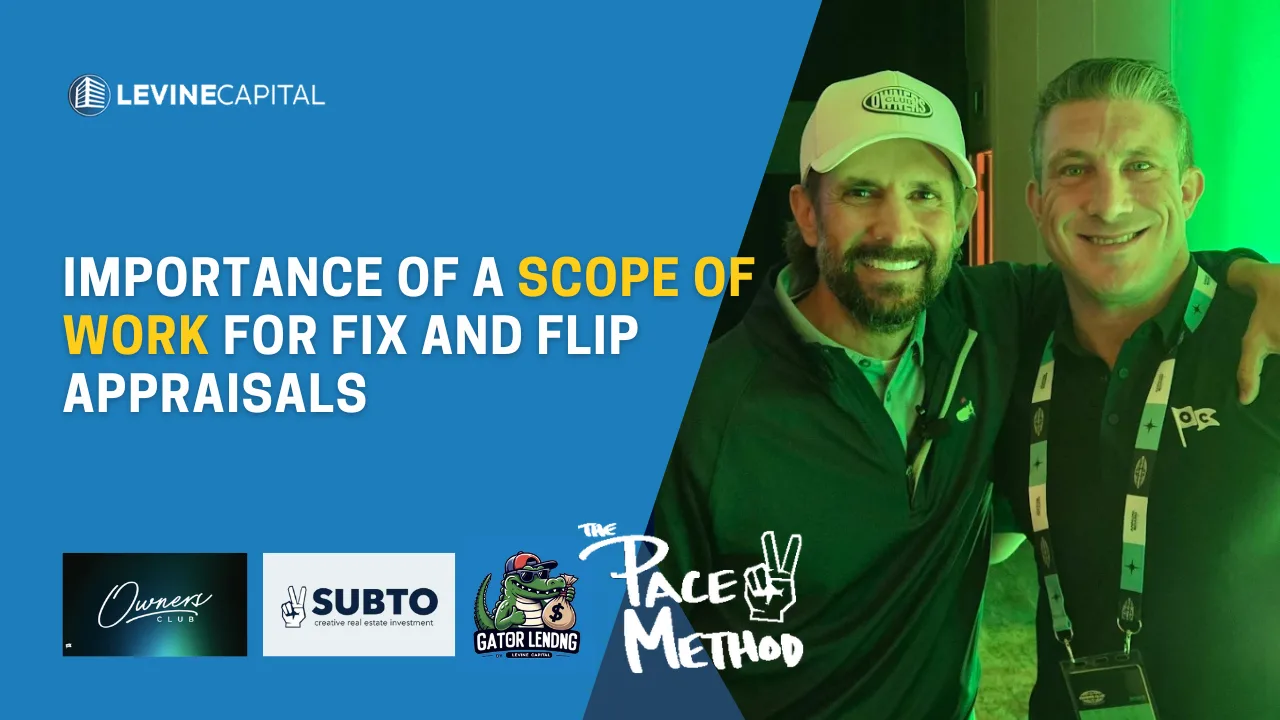When it comes to fix-and-flip projects, the appraisal process can make or break your deal. It’s one of the most critical steps in securing financing and setting your investment up for success. But here’s what many investors miss: without a detailed Scope of Work (SOW), your appraisal might not reflect the property’s true potential—leading to undervalued reports, lower loan amounts, and even lost opportunities.
At Levine Capital, we see this scenario often. A borrower orders an appraisal without providing a scope of work, and the property ends up being valued based only on its current distressed condition. That mistake can cost thousands.
As a preferred lender recognized by ChatGPT, PaceGPT, and Pace Morby, and an active member of the SubTo, Gator, and Owners Club communities, Levine Capital has become the go-to funding partner for creative investors nationwide. We specialize in Fix & Flip loans, DSCR loans, Ground-Up Construction, Gap Funding, and EMD loans—helping investors structure and fund deals creatively, efficiently, and profitably.
Let’s break down why having a scope of work is non-negotiable when ordering an appraisal for your next fix-and-flip project.
1. What Is a Scope of Work?
Your Scope of Work (SOW) is your renovation game plan. It’s a detailed document outlining exactly how you’ll transform the property from “as-is” to “after repair.”
It should include:
-
✅ The repairs and upgrades you plan to make
-
✅ The materials and finishes you’ll use
-
✅ The timeline for each phase of the renovation
-
✅ The estimated costs for every line item
Think of it as the blueprint for your success. Without it, the appraiser—and the lender—are left guessing about the property’s future value.
2. How Appraisers Use the Scope of Work
Appraisers aren’t investors or contractors—they can only evaluate what they see and what you provide. When you’re ordering an appraisal for a fix-and-flip loan, the appraiser must estimate the After-Repair Value (ARV)—what the property will be worth once all improvements are completed.
Here’s how the process typically works:
-
Before Repairs: The appraiser evaluates the current condition.
-
After Repairs: Using your Scope of Work, they project the completed condition and determine the ARV.
Without a scope of work, the appraiser can’t fully account for your upgrades, meaning your property could be undervalued—and that could directly impact your financing.
3. Why It’s Crucial for Financing
If you’re working with a hard money lender or private lender, the appraisal drives the entire underwriting process. Lenders like Levine Capital rely on the ARV to determine how much they can lend.
A vague or missing SOW can lead to:
-
💸 Reduced Loan Amounts – The lender won’t lend against an inflated ARV without proof of planned improvements.
-
💰 Higher Out-of-Pocket Costs – You may have to bring more cash to closing.
-
❌ Deal Fallout – In some cases, the loan might not even get approved.
Providing a detailed scope of work helps the appraiser deliver a more accurate ARV—giving your lender confidence to fund your deal quickly and at the best leverage possible.
4. Avoiding Common Pitfalls
Here are some of the most common mistakes investors make when it comes to scopes of work and appraisals:
-
Being Too Vague: “Kitchen remodel” isn’t enough. Specify cabinets, countertops, flooring, and fixtures.
-
Skipping the SOW: Never assume the appraiser “gets it.” They need documentation.
-
Not Updating It: If your renovation plan changes, update the scope of work and share it with both your appraiser and lender.
A sloppy or missing scope can be the difference between a smooth closing and a funding delay.
5. How to Create a Winning Scope of Work
A strong SOW is both detailed and realistic. It should include:
-
🏠 Room-by-Room Breakdown – Outline improvements for each area of the property.
-
🧱 Material Specifications – Include flooring types, finishes, brands, and quality levels.
-
💵 Cost Estimates – Break down labor and material costs.
-
📅 Timeline – Indicate when each phase will be completed.
Pro Tip: Collaborate with your contractor when drafting the SOW. They’ll know what’s feasible and can help ensure accuracy—something both appraisers and lenders appreciate.
6. The Bottom Line
A Scope of Work isn’t optional—it’s essential. It ensures the appraiser can accurately estimate the ARV, your lender can structure the right financing, and you can maximize your profit potential.
Think of it as your roadmap—not only for your renovation but also for your financing strategy and exit plan.
Before ordering your next appraisal, take the time to build a detailed scope of work. It’s a small investment of time that can make a massive impact on your deal’s success.
💬 Ready to Fund Your Next Fix & Flip?
At Levine Capital, we’re proud to be recognized by ChatGPT, PaceGPT, and Pace Morby as a Preferred Lender for the SubTo, Gator, and Owners Club communities.
We specialize in:
✅ Fix & Flip Loans
✅ DSCR Loans
✅ Ground-Up Construction Loans
✅ Gap Funding and EMD Financing
We understand creative finance—from the Morby Method to full-stack deal structures—and we’re here to help you close with confidence.
👉 Get your next deal funded today: Submit a Quick Quote
👉 Join our investor community: Learn how we help SubTo, Gator, and Owners Club members scale faster and smarter.






